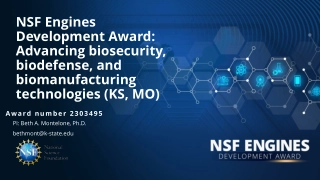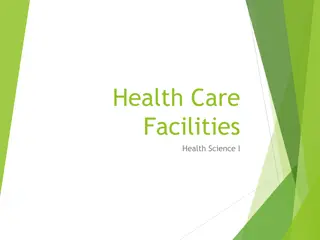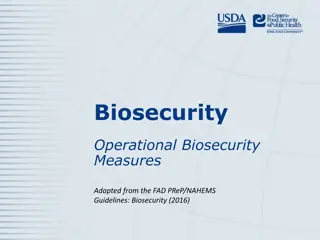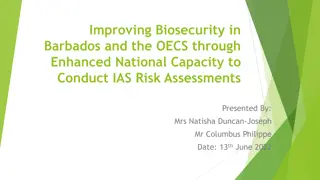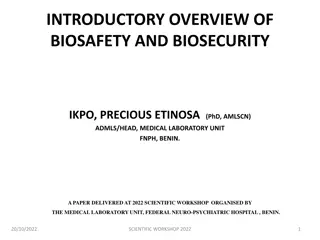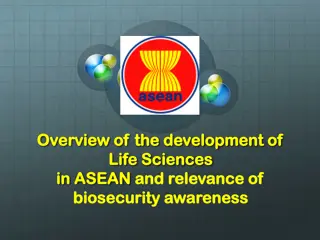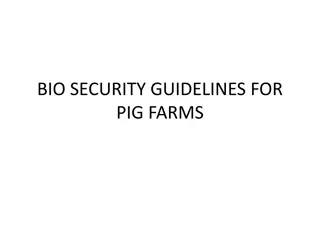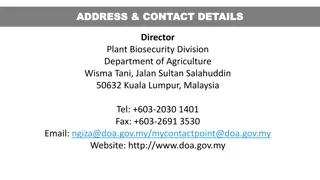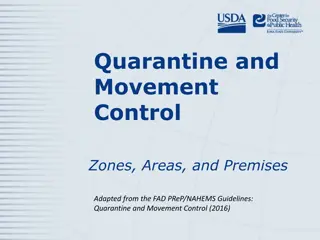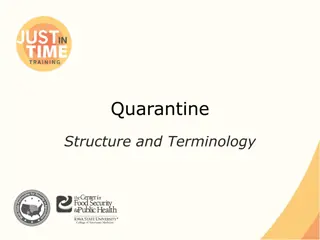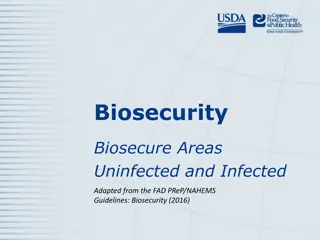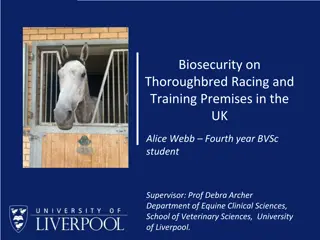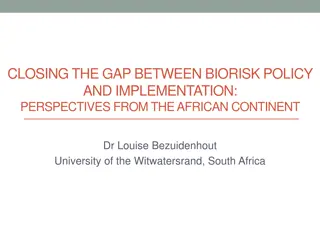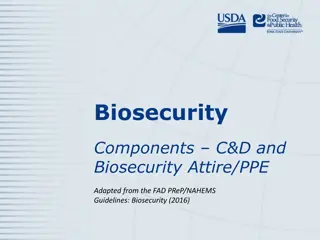Best Practices for Premises Biosecurity in Production Facilities
Operational recommendations for maintaining biosecurity in production facilities, focusing on bioexclusion and daily management. The guidelines cover the implementation of effective procedures, assigning responsibility and authority, role of a biosecurity officer/manager, training personnel, and ensuring compliance with the biosecurity plan to mitigate risks. The importance of separating clean and dirty areas for disease prevention is emphasized, as per FAD PReP/NAHEMS Guidelines.
Download Presentation

Please find below an Image/Link to download the presentation.
The content on the website is provided AS IS for your information and personal use only. It may not be sold, licensed, or shared on other websites without obtaining consent from the author. Download presentation by click this link. If you encounter any issues during the download, it is possible that the publisher has removed the file from their server.
E N D
Presentation Transcript
Biosecurity Premises Biosecurity for Bioexclusion Adapted from the FAD PReP/NAHEMS Guidelines: Biosecurity (2016)
This Presentation Operational recommendations Minimum measures for a production facility Focus on bioexclusion Normal day-to-day management Adapted from: Checklist for Self-Assessment of Enhanced Poultry Biosecurity, US Poultry and Egg Association, Poultry Biosecurity http://poultrybiosecurity.org/ FAD PReP/NAHEMS Guidelines: Biosecurity - Premises USDA APHIS and CFSPH
Premises Biosecurity Operational procedures Effective and more expedient than structural enhancements Minimum for day-to-day Mitigate common risks Enhanced/additional biosecurity, if foreign animal disease detected FAD PReP/NAHEMS Guidelines: Biosecurity - Premises USDA APHIS and CFSPH
Assign Responsibility Grant Authority FAD PReP/NAHEMS Guidelines: Biosecurity - Premises USDA APHIS and CFSPH
Biosecurity Officer/Manager Assigned individual, title may vary Develop site-specific biosecurity plan Implement effective procedures Institutionalize the plan Clearly written Trains all personnel with appropriate materials Address changing needs Monitor compliance by everyone FAD PReP/NAHEMS Guidelines: Biosecurity - Premises USDA APHIS and CFSPH
Biosecurity Officer/Manager contd Authority to: Stop violations Take corrective actions Certify the biosecurity plan has consistently been followed by all FAD PReP/NAHEMS Guidelines: Biosecurity - Premises USDA APHIS and CFSPH
Training of Personnel Ensure compliance Biosecurity plan communicated and distributed To everyone who accesses the facility Training on site-specific biosecurity procedures Training materials Documented, with ongoing audits and refreshers FAD PReP/NAHEMS Guidelines: Biosecurity - Premises USDA APHIS and CFSPH
Separation of Clean and Dirty FAD PReP/NAHEMS Guidelines: Biosecurity - Premises USDA APHIS and CFSPH
Line of Separation Line or barrier Imagined (i.e., painted line on the ground) Physical obstruction Separating clean from dirty Clean = non-infected Dirty = potential source of infection Clean/Dirty Line, C&D Line Site-specific Farm level, barn level, or between FAD PReP/NAHEMS Guidelines: Biosecurity - Premises USDA APHIS and CFSPH
Line of Separation contd Biosecurity plan addresses How Line is defined and defended For each type of movement across Point of crossing Critical control point to stop transfer of disease Limited access across Line FAD PReP/NAHEMS Guidelines: Biosecurity - Premises USDA APHIS and CFSPH
Perimeter Buffer Area Incorporated into plans for animals raised indoors Sanitation standard reduces pathogen load in the environment Additional separation between contaminated and non-contaminated Further protects susceptible animals Clearly delineated FAD PReP/NAHEMS Guidelines: Biosecurity - Premises USDA APHIS and CFSPH
Perimeter Buffer Area No visible contamination Keep premises traffic patterns within it Account for traffic patterns, topography, weather, and pathogen Reentry through a controlled access point C&D FAD PReP/NAHEMS Guidelines: Biosecurity - Premises USDA APHIS and CFSPH
Biosecurity Protocols FAD PReP/NAHEMS Guidelines: Biosecurity - Premises USDA APHIS and CFSPH
Personnel Personnel and clothing/footwear Site-specific procedures Actions required before arrival Actions at critical control points Limits/controls access of pathogen to clean area via personnel Shower/don clean outerwear Mandatory to cross Line of Separation and/or enter Perimeter Buffer Area FAD PReP/NAHEMS Guidelines: Biosecurity - Premises USDA APHIS and CFSPH
Danish Entry System An example of Line of Separation FAD PReP/NAHEMS Guidelines: Biosecurity - Premises USDA APHIS and CFSPH
Vectors Pets, Wildlife, and Insects Prevent transfer of disease by vectors (biological and mechanical) Address the exclusion or elimination of vectors Avoid environmental contamination Prevent the movement of contaminated material Mitigate situations and habitat that attract wildlife and scavengers FAD PReP/NAHEMS Guidelines: Biosecurity - Premises USDA APHIS and CFSPH
Equipment Clean and sanitize before crossing the Line of Separation Have sufficient equipment available Avoid sharing FAD PReP/NAHEMS Guidelines: Biosecurity - Premises USDA APHIS and CFSPH
Vehicles Exclude (unnecessary) vehicles from crossing the Line of Separation Thorough cleaning and disinfection prior to crossing Attention to wheels, wheel wells, and animal cargo areas Limit pathways of internal vehicles FAD PReP/NAHEMS Guidelines: Biosecurity - Premises USDA APHIS and CFSPH
Carcass/Manure Disposal Protect susceptible animals from exposure Avoid cross-contamination of pathways Keep disposal service vehicles outside the Line of Separation Prevent attracting wild animals or scavengers FAD PReP/NAHEMS Guidelines: Biosecurity - Premises USDA APHIS and CFSPH
Animals Closed herd or additions with documented health status Isolate new animals for 30 days All-in/all-out management Housing cleaned between groups Animals transported in cleaned and disinfected vehicles FAD PReP/NAHEMS Guidelines: Biosecurity - Premises USDA APHIS and CFSPH
Feed, Bedding/Litter, Water Supply Can be contaminated if exposed to pathogens Store and handle properly Immediately clean grain spills Deliveries at remote locations Use water from deep wells or treated sources FAD PReP/NAHEMS Guidelines: Biosecurity - Premises USDA APHIS and CFSPH
Continuity of Business Secure Food Supply Plans Guidelines to minimize disease spread and ensure safe wholesome supply Specific biosecurity standards Available plans: Secure Poultry Supply Secure Milk Supply Secure Pork Supply FAD PReP/NAHEMS Guidelines: Biosecurity - Premises USDA APHIS and CFSPH
Conclusion Biosecurity Maintains food safety and security Protects the environment Facilitates continuity of business Excludes/contains disease Site- and circumstance-specific Consistent compliance FAD PReP/NAHEMS Guidelines: Biosecurity - Premises USDA APHIS and CFSPH
For More Information FAD PReP/NAHEMS Guidelines & SOP: Biosecurity (2016) http://www.aphis.usda.gov/fadprep Biosecurity web-based training module: http://naherc.sws.iastate.edu/ FAD PReP/NAHEMS Guidelines: Biosecurity - Premises USDA APHIS and CFSPH
Guidelines Content Authors (CFSPH) Janice P. Mogan, DVM Heather Allen, PhD, MPA Kristen Bretz, MS Reviewers (USDA) Jonathan T. Zack, DVM James A. Roth, DVM, PhD, DACVM FAD PReP/NAHEMS Guidelines: Biosecurity - Premises USDA APHIS and CFSPH
Acknowledgments Development of this presentation was by the Center for Food Security and Public Health at Iowa State University through funding from the USDA APHIS Veterinary Services PPT Authors: Janice P. Mogan, DVM; Logan Kilburn Reviewer: Kristen Bretz, MS


